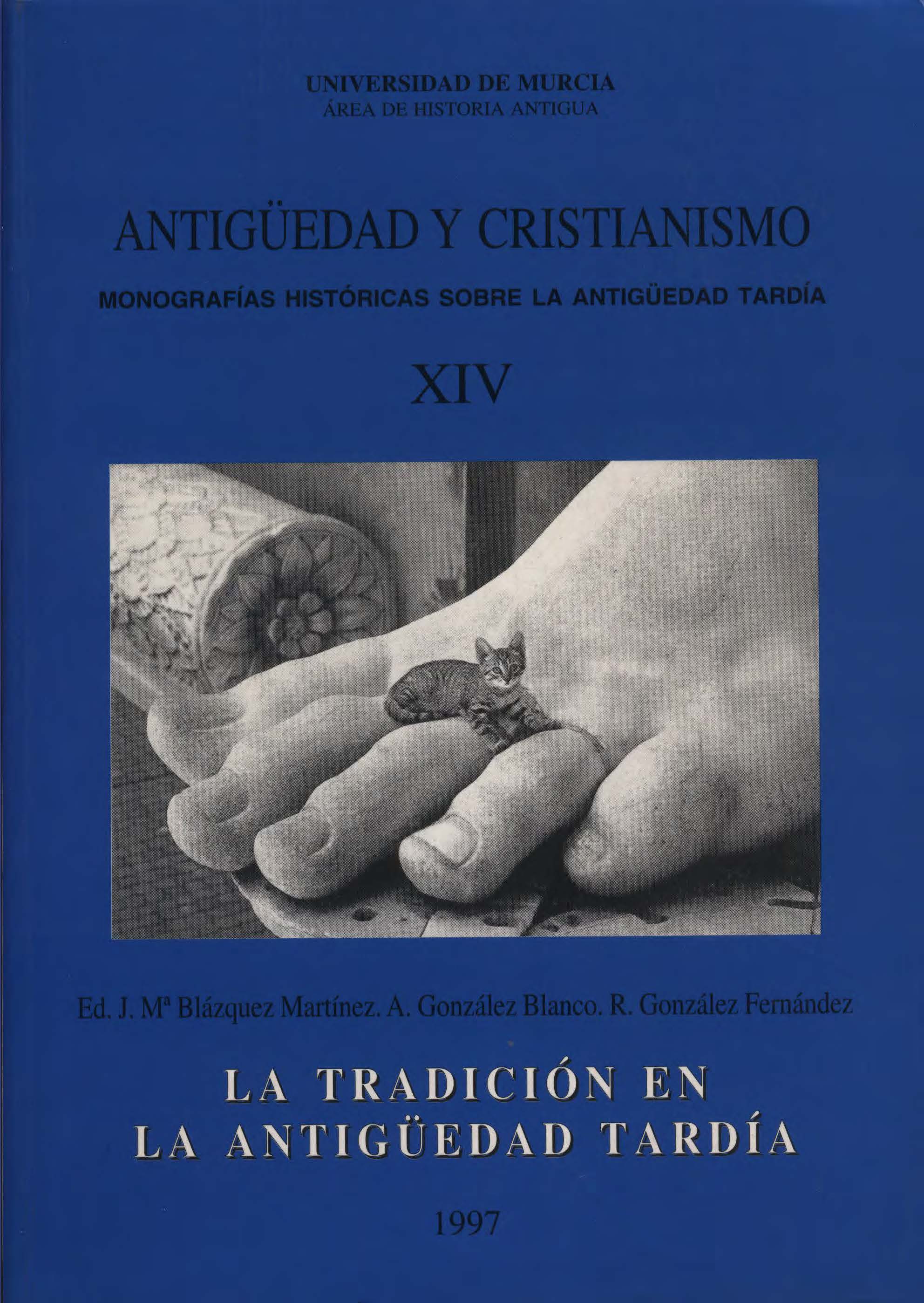COMPOSITIVE STUDIES OF SOME PALE-CHRISTIAN BASILICAS IN ROMAN SPAIN FROM THE IV-VI CENTURIES
Abstract
The present paper attempts the study of the previous schemas and the distinctive features of the constructive system of religious architecture on the Iberic peninsula during the Late Antiquity.
Downloads
-
Abstract512
-
PDF (Español (España))345
References
ALVAREZ MARTÍNEZ, J.M.: Mosaicos romanos de Mérida. Nuevos hallazgos, Mérida, 1990, 82-83, Iáms. 39-41.
ARGENTE, J.L.: «La villa tardorromana de Baños de Valdearados (Burgos)», EAE, Madrid, 1979, 61, fig. 19, lám. VIII.2. GUARDIA, M.: Op. cit., 125, gráf. 15.
BALTY, J.: Mosaiques antiques de Syrie, Bruselas, 1977, 36-41.
BLANCO, A,: Mosaicos antiguos de asunto báquico, Madrid, 1952,49, fig. 15. Id., Mosaicos romanos de Mérida, 34, lám. 26.
Blázquez, J.M. y Mezquiriz, M.A.: Mosaicos romanos de Navarra, Madrid, 1985, 64, lám. 40. 6 Roma. El jin del arte antiguo, Madrid, 1971, 193, fig. 185.
BLÁZQUEZ, J.M.: «Platería sasánida: cuencos con retratos y platos con cacerías reales*, Goya 239, 1994, 258-269.
BLÁZQUEZ, J.M.: Mosaicos romanos de España.
BLÁZQUEZ, J.M.: Mosaicos romanos de la Real Academia de la Historia. Ciudad Real, Toledo, Madrid y Cuenca, Madrid, 1982, 45-46.
CAMPBELL, S.: The Mosaics of Antioch, Toronto, 1988.
CARANDINI, A. y otros: Filosofiana. La Villa di Piazza Armerina, Palermo, 1982, figs. 29, 146, 158, 159, 160, 164-166, 200,208-209.
CASTILLO, A,: «La Costa Brava en la Antigüedad en particular la zona entre Blanes y San Feliu de Guisols. La villa romana de Tossan, Ampurias 1, 1939, 260. 16 «Las escuelas musivarias del Conventus tarraconensis*, CMGR, 1963, 35, fig. 13.
COLLEDGE, M.A.R.: The Art of Palmira, Londres, 1976, 84-87, figs. 115-116.
DORIGO, W.: Pittura tardorromana, Milán, 1966, 99-101.
DURAN, M.: Iconografía de los mosaicos romanos en la Hispania alto-imperial, Barcelona, 1993, 182, lám. XXV, n. 45. 18 BLANCO, A.: Mosaicos romanos de Italica (1). Mosaicos conservados en las colecciones públicas y particulares de la ciudad de Sevilla, Madrid, 1978, 54, Iám. 76.
FERNÁNDEZ GALIANO, D.: «El triunfo de Dionisos en mosaicos hispano-romanos*, AEspA 57, 1984, 97-120.
FERNANDEZ GALIANO, D.: Complutum 11. Los mosaicos, Madrid, 1984,79-81, lám. LIV, con el catálogo de los retratos hispanos a los que hay que añadir los aparecidos últimamente.
GARCÍA Y BELLIDO, A.: Arte romano, Madrid, 1972,642, figs. 1136-1 137.
GARCÍA-HOZ, M.C. y otros: «La villa romana del «Olivar del Centeno* (Millares de la Mata, Cáceres)~, Extremadura Arqueológica 111, 1991, 387-402, figs. 3-4,8, láms. 1-11,
GIMENO, H.: «Epigrafía romana sobre mosaicos en Hispaniax, Religio Deorum, Sabadell, 1992. Id.: «Primer esbozo para un Corpus de inscripciones musivanas de Hispania~, Universitas Tarraconensis (Sección Filológica) 12, 1988-89, 197-249.
GOMEZ, J.: «Nombres de artistas en inscripciones musivarias latinas e ibéricas de Hispania*, Epigraphica 53, 1991, 59-96.
GUARDIA, M.: Los mosaicos de la antigüedad tardía en Hispania. Estudios de iconografia, Barcelona, 1992, 152, figs. 58,64-65, graf. 21.
HARPER, P.O. y MEYERS, P.: Silver Vessels of the Sasanian Period 1. Royal Imagenery, New York, 1981.
LANCHA, J.: «Les mosaistes dans la vie ecónomique de la Péninsule Ibérique, du er. au IV sikcle état et de la question et quelques hyphot&ses», MCV 20, 1984, 45-61.
LEVI, D.: Antioch Mosaics Pavements, Princeton , 1947.
LÓPEZ MONTEAGUDO, G.: «El programa iconográfico de la Casa de los Surtidores de Conimbrigan, Espacio, Tiempo y Forma, 11, 3, Historia Antigua, 1990, 214-215, figs. 17-1 8, 20.
LOPREATO, P.: « Le grandi terme di Aquileia, 1 mosaici del frigidariumn, CMGR IV, 1994, 95-96, 99.
OVADIAH, R.A.: Mosaics Pavements in Israel, Roma, 1987.
PACO, A. do: «Mosaicos romanos de la Villa de Cardilius en Torres Novas (Portugal)», AEspA 37,1964,85, fig. 10.
PALOL, P. de y CORTES, J.: «La villa romana de La Olmeda. Pedrosa de la Vega (Palencia). Excavaciones de 1969 y 1970», 1. AAH 7, Madrid, 1974,42-44, figs. 13-19, lám. XXXIX-XLV, XLVII-XLVIII.
PARRISH, D.: Season Mosaics of Roman North Africa, Madrid, 1984, 11 1-1 13, láms. 15-16.
PICCIRILLO, M.: I mosaici di Giordania, Roma, 1986, 72-73, fig. 57. Cat. 1. Id., I mosaici di Giordania, Cat. 141-143. Id.: Mudaba le chiese e i mosaici, Tunn, 1989, entre pp. 96-97, 191, 330.
PICCIRILLO, M.: I mosaici di Jordania, 74-75. SCHIK, R.: Op. cit., 219.
PICCIRILLO, M.: Madaba le chiese i mosaici, 288-289. Id., I mosaici di Jordania, Cat. 75-76. Id.: «The Mosaics at Un er-Rasas in Jordan», Biblical Archaeologist 51, 1988, 212.
SCHICK, R.: ~Christian Life in Palestine during the Early Islamic Period*, Biblical Archaeologist, 218.
SCHLUNK, H.: «Die Mosaikkuppel von Centcelles», Madrider Beitrage, Maguncia, 1988, 13, 78, 85, 97-98, 136, 139, 145, 149-150, 152-154, 172, lám. 3, 20 c, 21,24a, 69a.
The Mosaics of Roman North Africa. Studies in lconography and Patronages, Oxford, 1978, 196-212. 5 BLÁZQUEZ, J.M.: Mosaicos romanos de España, Madrid, 1993, 227-231.
1. The authors non-exclusively assign the exploitation rights (reproduction, distribution, communication and transformation) to the magazine.
2. The works published in this magazine are subject to the Attribution-ShareAlike 4.0 International license (CC By SA 4.0). Therefore, they can be copied, used, disseminated, transmitted and publicly displayed, provided that:
i) the authorship and the original source of its publication (journal, editorial and URL of the work) are cited, thus allowing its recognition.
ii) it is allowed to remix, transform or create from the material while maintaining the same license as the original.
Note: Articles prior to 2022 incorrectly display the CC by SA license in the abstract page. They are under a CC by NC ND license as embedded in the article pdfs. Articles published in 2022 and after are under the CC by SA license.

3. Self-archiving conditions. Authors are allowed and encouraged to electronically disseminate the pre-print (version before being evaluated) and/or post-print (version evaluated and accepted for publication) versions of their works before publication, as it favors their publication. Earlier circulation and diffusion and with it a possible increase in its citation and reach among the academic community. Color RoMEO: verde.
























